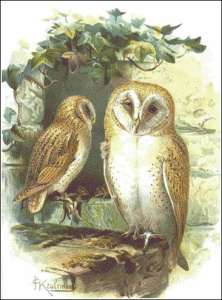 As I drifted off to sleep, I heard a great horned owl call in the distance “hoo-h’HOO-hoo-hoo.”
As I drifted off to sleep, I heard a great horned owl call in the distance “hoo-h’HOO-hoo-hoo.”
I listened intently, wanting to confirm what I had heard. The house was as silent as a tomb. My relatives had long since retired to bed. As my ears strained in the darkness, I thought back to one of the most interesting and strange classes I have ever taken.
Owl Class
Thoughts of Harry Potter paraded through my head as I strolled into “Owl Class”. The class began at 6:00 PM in the fading light. I was at Point Reyes National Seashore, one of the most beautiful and overlooked national parks in our country.
The classroom was a renovated barn near the park’s visitor center. The lesson was divided into three sections. First was a presentation on the seven resident species in this part of California. Second was a face-to-face with three captive owls. And finally there was a night-hike adventure visiting three separate owl “hot spots” in the park.
Guess Hoo?
I’ll start with some pictures of the owls we met in class. These birds are HUGE!!! The pictures do not do them justice.
Barn Owl
Notice heart-shaped facial disk.
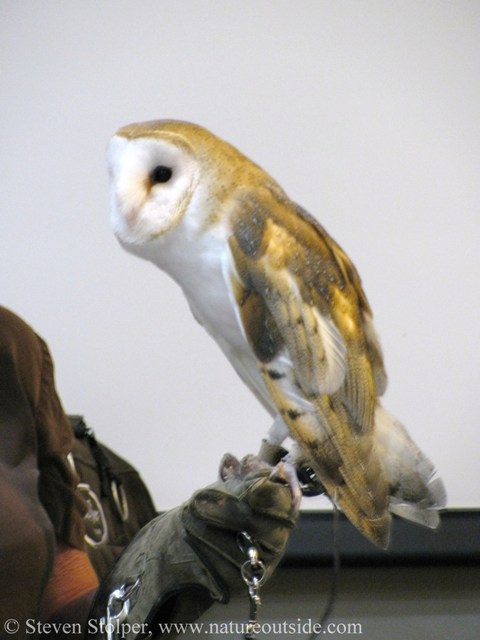
Barn Owl (Tyto alba)
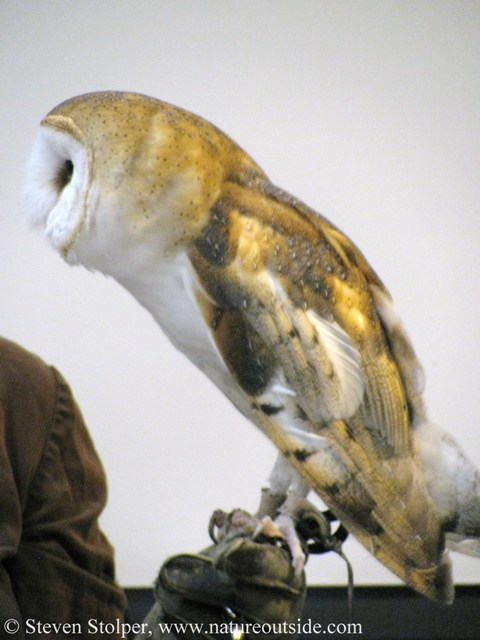
It is hard to tell from my pictures. But these animals are BIG.
Spotted Owl
Notice the big black eyes.
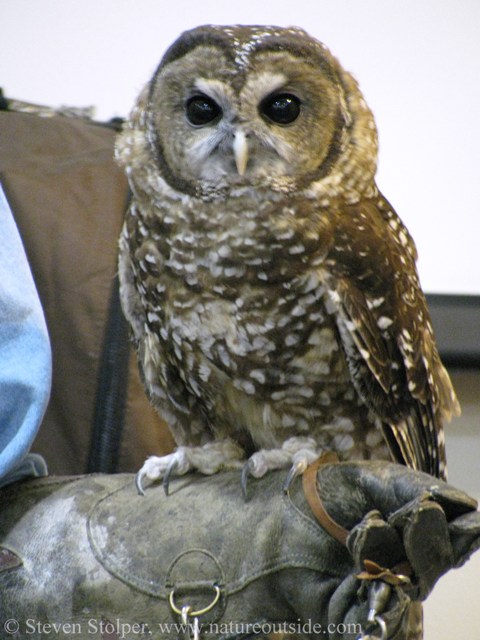
Spotted Owl (Strix occidentalis).
According to the Cornell Lab of Ornithology, because of its role as an indicator species for old-growth forest it has become one of the best-studied owls in the world.
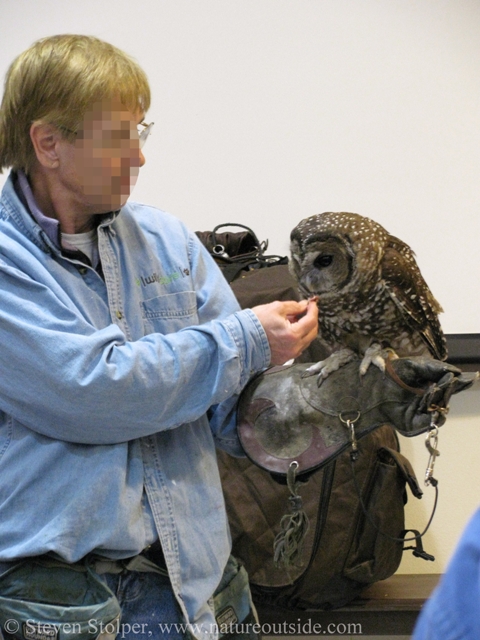
Having a treat
Eurasian Eagle-Owl
These birds are found in northern latitudes in Europe and Asia. Eagle Owls are not native to the United States. They are the largest owls in the world. Notice that Old World owls have orange eyes, not yellow like we have in the US.
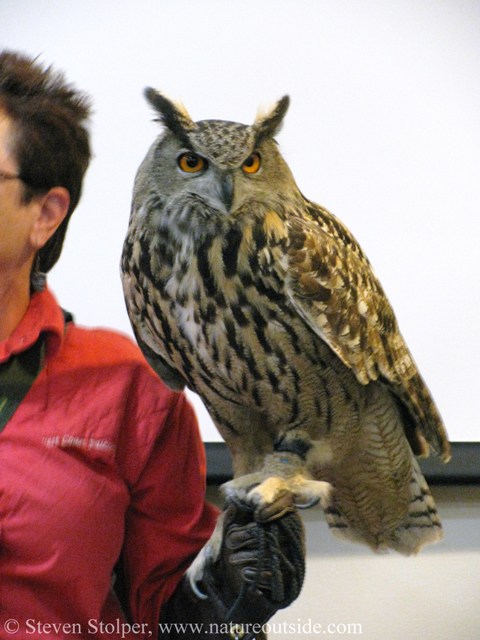
Eurasian Eagle-Owl (Bubo bubo)
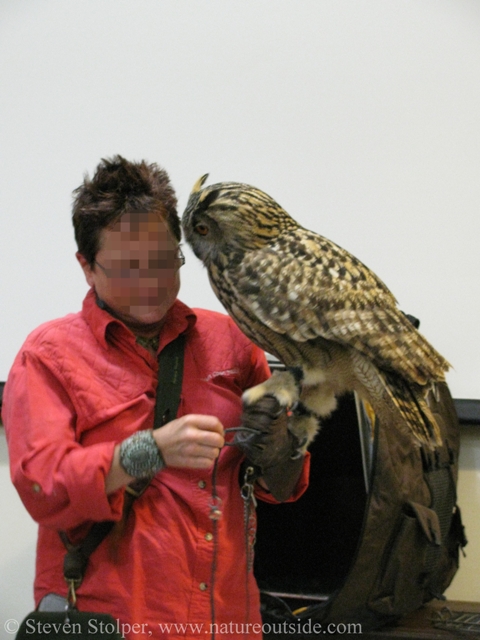
Eurasian Eagle-Owls are the largest owls in the world
Seven Owl Species in Northern California
Here are the seven species we learned about (from my notes and the handouts). If you get the chance, find some field guides and look them up.
1. Great Horned Owl (Bubo virginianus)
The Great Horned Owl is nicknamed, “The Tiger of the Air!” They fill the same niche as Red Tail Hawks, but at night (“niche switch”). The Great Horned Owl is the heaviest and most powerful American owl. They stand 1.5-2 feet tall, with a wingspan of 3-5.5 feet. They prefer dense wooded areas. Key field marks include prominent ear tufts, big yellow eyes, and a tawny facial disk.
2. Western Screech-Owl (Megascops kennicottii )
An interesting fact: Screech owls do not screech. They niche switch with the American Kestrel. Screech owls prefer open woodland near streams. They stand 7-11 inches tall but they have a wingspan of 1.5-2 feet!
3. Northern Pygmy-Owl (Glaucidium gnoma)
This owl is diurnal! It is a diminutive 6.5-7 inches tall with a wingspan of 14-16 inches. But it is known to take prey 20 times its weight! Pygmy owls are often mobbed by songbirds and driven away. Look for it in open coniferous forest.
4. Spotted Owl (Strix occidentalis)
The Spotted owl is a relative of the barred owl, but meeker. It stands 16-19 inches tall with wingspan of 42-45 inches. It likes old growth forest and groves of mature trees. As you might guess, that’s why it is a “threatened” species!
5. Northern Saw-Whet Owl (Aegolius acadicus)
This owl competes with the Screech owl. Saw-Whet owls stand 7-8 inches tall, about the size of a Baltimore oriole (the bird not the baseball player). They have a wingspan of 17-21 inches. Its head looks huge in proportion to body.
If you hear one, you will know it! The Saw-Whet repeats its whistle mechanically from 100-130 times per minute. And it can repeat its call all night long! This can drive people crazy!!! 🙂
6. Common Barn Owl (Tyto alba)
You can recognize these helpful owls by their heart-shaped facial disk. A family of barn owls can consume up to 3,000 rodents each year! One pair of barn owls can eliminate more mice per night than ten cats put together. They stand about 14-21 inches tall with a wingspan of 3-4 feet!
7. Western Burrowing Owl (Athene cunicularia)
This owl lives in underground burrows like a ground squirrel! It likes prairies and open grassland. Burrowing owls stand 8.5-11 inches tall with wings of 20-24 inches.
During the day, I often see these owls standing guard near their burrows. Since they are ground nesting, burrowing owls are endangered by housing developments that rampantly consume all of the open land.
Our Night Hike
The last part of the class was a night hike. It was amazing! We hiked without flashlights and as quietly as we could. We flushed a barn owl and heard great horned owls calling. We found pellets in a “graveyard” of bones below a tree where owls have lived for 20 years. In the future, I am going to try to go on more night hikes of my own.
Looking for Owls During the Day?
Most owls hide during the day to keep from being “mobbed” by birds and driven away. They sit on branches, close to the main trunk, in an effort to blend in. Keep this in mind if you look for them during the day.
Owls Have Stealth Technology
In class, the teachers described at some length how nocturnal owls have specialized flight feathers for quiet flight. A kind of “stealth technology!” The wispy feathers on the trailing edges of their wings prevent vortices and turbulent airflow that generate noise. I later read that they also have “downy” feathers to absorb noise that would alert prey as they close in to strike them.
Owl You Need is Love
One big threat to owls is that most of us cut down our dead trees. These tend to be nesting sites for cavity dwelling owls. Apparently it is not too difficult to put up a nest box for owls. But its construction and location have to be perfect or the owls will die from one of a variety of threats. For that reason some organizations sell/provide owl boxes and free consultation to people who will put them up. Something to think about if you own property…
True Magic
As I lay there in my relatives’ house, I heard the call repeated, “hoo-h’HOO-hoo-hoo.” I smiled in the night. This was a rare privilege for me. The relatives who I was visiting live in a quiet wooded neighborhood. My own home is too close to a busy freeway for me to hear the calls of owls.
I listened a few more minutes before drifting off to sleep. All the while recalling the strange and magical “owl class.” Observing owls is a great activity to do in camp after a long day on the trail. That class opened my eyes to it.
If you liked this article, check out others in the Nature Section.


Hi Steve, we are wondering if it would make sense to set up an owl box in our school garden to keep the rats from eating all our veggies. It’s in a residential area without a lot of big trees. Who would you suggest we contact?
Susan, there’s a non-profit organization called the Hungry Owl Project that can answer your questions. It consults with homeowners and organizations, sells nesting boxes, has box plans (if you’d like to build your own) and can help with just about every aspect of owl boxes. Here is a link to their website Hungry Owl Project – Nest Box Overview.